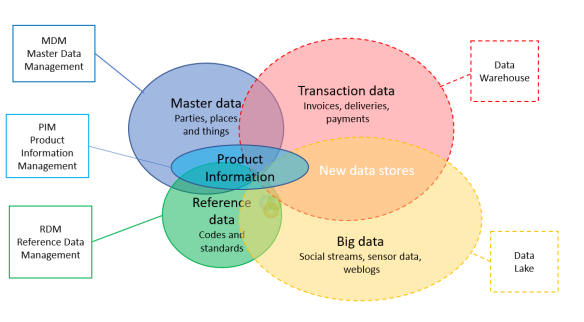Product Information Management (PIM) has a sub discipline called Product Data Syndication (PDS).
While PIM basically is about how to collect, enrich, store and publish product information within a given organization, PDS is about how to share product information between manufacturers, merchants and marketplaces.

Marketplaces
Marketplaces is the new kid on the block in this world. Amazon and Alibaba are the most known ones, however there are plenty of them internationally, within given product groups and nationally. Merchants can provide product information related to the goods they are selling on a marketplace. A disruptive force in the supply (or value) chain world is that today manufacturers can sell their goods directly on marketplaces and thereby leave out the merchants. It is though still only a fraction of trade that has been diverted this way.
Each marketplace has their requirements for how product information should be uploaded encompassing what data elements that are needed, the requested taxonomy and data standards as well as the data syndication method.
Data Pools
One way of syndicating (or synchronizing) data from manufacturers to merchants is going through a data pool. The most known one is the Global Data Synchronization Network (GDSN) operated by GS1 through data pool vendors, where 1WorldSync is the dominant one. In here trading partners are following the same classification, taxonomy and structure for a group of products (typically food and beverage) and their most common attributes in use in a given geography.
There are plenty of other data pools available emphasizing on given product groups either internationally or nationally. The concept here is also that everyone will use the same taxonomy and have the same structure and range of data elements available.
Data Standards
Product classifications can be used to apply the same data standards. GS1 has a product classification called GPC. Some marketplaces use the UNSPSC classification provided by United Nations and – perhaps ironically – also operated by GS1. Other classifications, that in addition encompass the attribute requirements too, are eClass and ETIM.
A manufacturer can have product information in an in-house ERP, MDM and/or PIM application. In the same way a merchant (retailer or B2B dealer) can have product information in an in-house ERP, MDM and/or PIM application. Most often a pair of manufacturer and merchant will not use the same data standard, taxonomy, format and structure for product information.
1-1 Product Data Syndication
Data pools have not substantially penetrated the product data flows encompassing all product groups and all the needed attributes and digital assets. Besides that, merchants also have a desire to provide unique product information and thereby stand out in the competition with other merchants selling the same products.
Thus, the highway in product data syndication is still 1-1 exchange. This highway has these lanes:
- Exchanging spreadsheets typically orchestrated as that the merchant request the manufacturer to fill in a spreadsheet with the data elements defined by the merchant.
- A supplier portal, where the merchant offers an interface to their PIM environment where each manufacturer can upload product information according to the merchant’s definitions.
- A customer portal, where the manufacturer offers an interface where each merchant can download product information according to the manufacturer’s definitions.
- A specialized product data syndication service where the manufacturer can push product information according to their definitions and the merchant can pull linked and transformed product information according to their definitions.
In practice, the chain from manufacturer to the end merchant may have several nodes being distributors/wholesalers that reloads the data by getting product information from an upstream trading partner and passing this product information to a downstream trading partner.
Data Quality Implications
Data quality is as always a concern when information producers and information consumers must collaborate, and in a product data syndication context the extended challenge is that the upstream producer and the downstream consumer does not belong to the same organization. This ecosystem wide data quality and Master Data Management (MDM) issue was examined in the post Multienterprise MDM.





